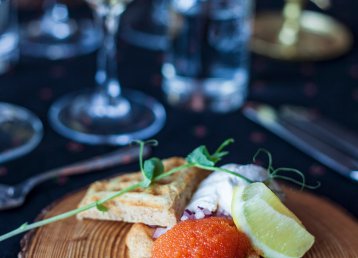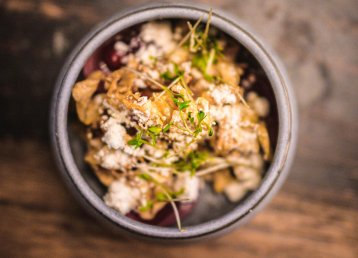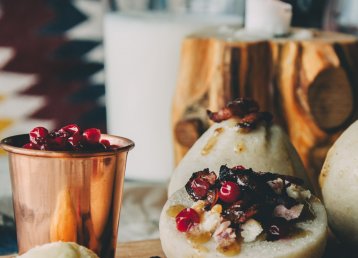At home in her kitchen, Ingrid Pilto is preparing blood dumplings. The autumn slaughter provides quite a lot of blood and fat. “Healthy fat,” as Ingrid is quick to point out. The fat of the reindeer is part of an eco cycle unto its own. The animal fattens up in spring and summer, only to lose its fat during winter. This explains why it is healthy; few toxins accumulate in the reindeer’s fatty tissue. Some even believe it is better to cook with reindeer fat than with olive oil or rapeseed oil. The ratio of Omega 3 to Omega 6 is also optimal. Naturally, and furthermore, the fat is a natural flavour enhancer.
Gurpi and suovas
While the blood dumplings cook, Ingrid prepares a thin membrane of caul, which surrounds the innards. This is for a gurpi, a sort of crépinette, which Ingrid will make later. The gurpi, from the Sámi word gurpat, meaning ‘to tie together’, is a kind of sausage made from minced reindeer meat, and lightly smoked and frozen so that it can be conveniently taken on a trip.
In recent years, both gurpi and suovas (salted, lightly smoked reindeer) have become best sellers. Suddenly, tastebuds the world over have become enamoured with the old ways of preserving and preparing meat. On the menus of leading eateries, smoking, drying, and pickling are all the rage.
Ingrid expertly carries the traditions forward. Her poached sea trout is a classic. Her gurpi differs from all others. If it is seasoned, it certainly isn’t with something you’d find on the grocer’s shelf. Ingrid maintains high standards when it comes to Sámi fare. With reindeer meat, she eschews seasonings. The meat is cold-smoked which, together with the crépinette, gives the gurpi its flavour.
The art of cookery
All reindeer meat differs in flavour from one season to the next. Summer reindeer, from animals that have eaten almost nothing but grass, is particularly mild. Meat from bulls that have been slaughtered in the autumn is richer since the animals have begun to eat wild fungi, which imparts more flavour to the meat. Meat from the winter slaughter is the gamiest. This is because fodder is scarce and the animals have foraged for lichens. A bearer of tradition, Ingrid is a Sámi home cook who knows the secrets behind good food. And she knows that it is both possible and necessary to develop the art of cookery.
There are several aortas in a bucket on the front porch. They remind me of the over-cooked pasta that they served us for school lunches. In the old days, the Sámi boiled aortas and ate them, just as they are, like spaghetti. Nowadays, explains Ingrid, when battered and deep-fried, they are a bit like calamari in terms of both taste and consistency. My mouth begins to water. Sámi cooking is changing and, of course, there are modern versions of all the dishes, but the reindeer remains the same. Everything must be used from this animal, which is the heart and soul of cultural identity, and nothing discarded.
Also read
The taste of Swedish LaplandThe number one rule
English celebrity chef Fergus Henderson helped to popularize ‘whole beast’ or ‘nose-to-tail eating’ at his Michelin-starred restaurant St John in London. In the words of Fergus Henderson, “If you’re going to kill the animal, it seems only polite to use the whole thing.” But this is nothing new. Making use of the whole animal has always been rule number one in a society of hunter-gatherers. I don’t believe for a minute that the French would have eaten snails, oysters or woodcock with the innards if the freezer had been full of corn-fed fillet steak. Only in our careless, throw-way consumer society is it acceptable to prefer chicken breasts to thighs.
Everything has a use
– Imagine if everyone ate the way we do, says Ingrid, looking at me intently.
– I don’t think we can afford it, I reply, laughing. You know, ptarmigan and arctic char don’t come cheap.
– No, that’s not really what I mean. I mean, like Per-Nils and I, we use everything and do the cooking ourselves.
I understand what she means. But it’s sometimes good to be reminded.
Have you ever eaten the muzzle? Or blood pancakes made from dried reindeer blood that has been dried in an inside-out stomach before being mixed into the pancake batter? For the Sámi, the reindeer is no throw-away item. Hides were tanned for clothing, sinews became sewing thread, antlers were ideal for knife handles and other tools, and the hooves were boiled for glue. Nothing was worthless; everything had a use.


























